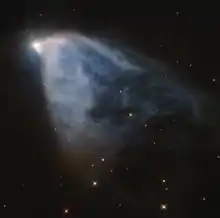NGC 2261
NGC 2261 (also known as Hubble's Variable Nebula or Caldwell 46) is a variable nebula located in the constellation Monoceros. The nebula is illuminated by the star R Monocerotis (R Mon), which is not directly visible itself.
| Reflection nebula | |
|---|---|
| Variable Nebula | |
 | |
| Observation data: J2000.0 epoch | |
| Right ascension | 6h 39m 10s[1] |
| Declination | +8° 45′[1] |
| Distance | 2,500 ly |
| Apparent magnitude (V) | 9.0 |
| Apparent dimensions (V) | 2′ |
| Constellation | Monoceros |
| Designations | Hubble's Variable Nebula,[1] Caldwell 46 |
Observing history
The first recorded observation of the nebula was by William Herschel on 26 December 1783, being described as considerably bright and 'fan-shaped'.[2] It had long been designated as H IV 2, after being the second entry of Herschel's class 4 category for nebulae and star clusters, in his catalogues of nebulae.[3]
NGC 2261 was imaged as Palomar Observatory's Hale Telescope's first light by Edwin Hubble on January 26, 1949,[4] some 20 years after the Palomar Observatory project began in 1928. Hubble had studied the nebula previously at Yerkes and Mt. Wilson.[4] Hale had taken photographic plates with a 24-inch (60.96 cm) reflecting telescope in 1916.[5] Also, plates were taken using the same telescope in 1908 by FC Jordan, allowing Hale to use of a blink comparator to study any changes in the nebula.[5]
NGC 2261 was imaged by the Hubble Space Telescope, and an image of the nebula was released in 1999.[6]
A timelapse of NGC 2261 was taken over a period of 6 months by over 20 amateur astronomers at the Big Amateur Telescope from October 2021 – April 2022. In August 2022, the project was resumed as NGC 2261 came out from behind the Sun.[7]

Descriptions
The star R Monocerotis has lit up a nearby cloud of gas and dust, but the shape and brightness slowly changes visibly even in small telescopes over weeks and months, and the nebula looks like a small comet.[8]
One explanation proposed for the variability is that dense clouds of dust near R Mon periodically block the illumination from the star.[9] This casts a temporary shadow on the nearby clouds.[10]
See also
References
- "NGC 2261". SIMBAD. Centre de données astronomiques de Strasbourg. Retrieved 2007-04-11.
- Herschel, William (1786). "Catalogue of One Thousand New Nebulae and Clusters of Stars. By William Herschel, LL.D. F. R. S." Philosophical Transactions of the Royal Society of London. 76: 457–499. ISSN 0261-0523. JSTOR 106639.
- Duncan, John C. (1956). "Lampland's Study of Hubble's Variable Nebula, NGC 2261". Publications of the Astronomical Society of the Pacific. 68 (405): 517–519. doi:10.1086/126989. ISSN 0004-6280. JSTOR 40676213. S2CID 119513655.
- "Citizen Science". 26 January 2009.
- Hubble, E. P. (1916). "The variable nebula NGC 2261". Astrophysical Journal. 44: 190. Bibcode:1916ApJ....44..190H. doi:10.1086/142284.
- "Hubble's variable nebula (NGC 2261)". www.spacetelescope.org. Retrieved 2018-07-25.
- "Hubble's variable nebula Project". bigamateurtelescope.com. Retrieved 2022-12-24.
- "Hubble's Variable Nebula, NGC 2261". Planetary Science Institute. 2010-10-15. Retrieved 2018-07-25.
- Arny, T. T.; Bechis, K. P. (1978). "A model for the cometary nebula NGC 2261". The Astrophysical Journal. 226: 455. Bibcode:1978ApJ...226..455A. doi:10.1086/156627.
- "NGC 2261: Hubble's Variable Nebula | Science Mission Directorate". science.nasa.gov. Retrieved 2018-07-25.
External links
- European Homepage for the HST – Hubble photos and information on NGC 2261
- wikispaces.com Archived 2013-02-09 at archive.today – Images by amateur astronomers
- Astrobiscuit: Seeing The Speed Of Light fun and educational video about variable nebula and the amateur community observing them
- NASA Astronomy Picture of the Day: NGC 2261: Hubble s Variable Nebula (November 8, 2017)
- NGC 2261 on WikiSky: DSS2, SDSS, GALEX, IRAS, Hydrogen α, X-Ray, Astrophoto, Sky Map, Articles and images